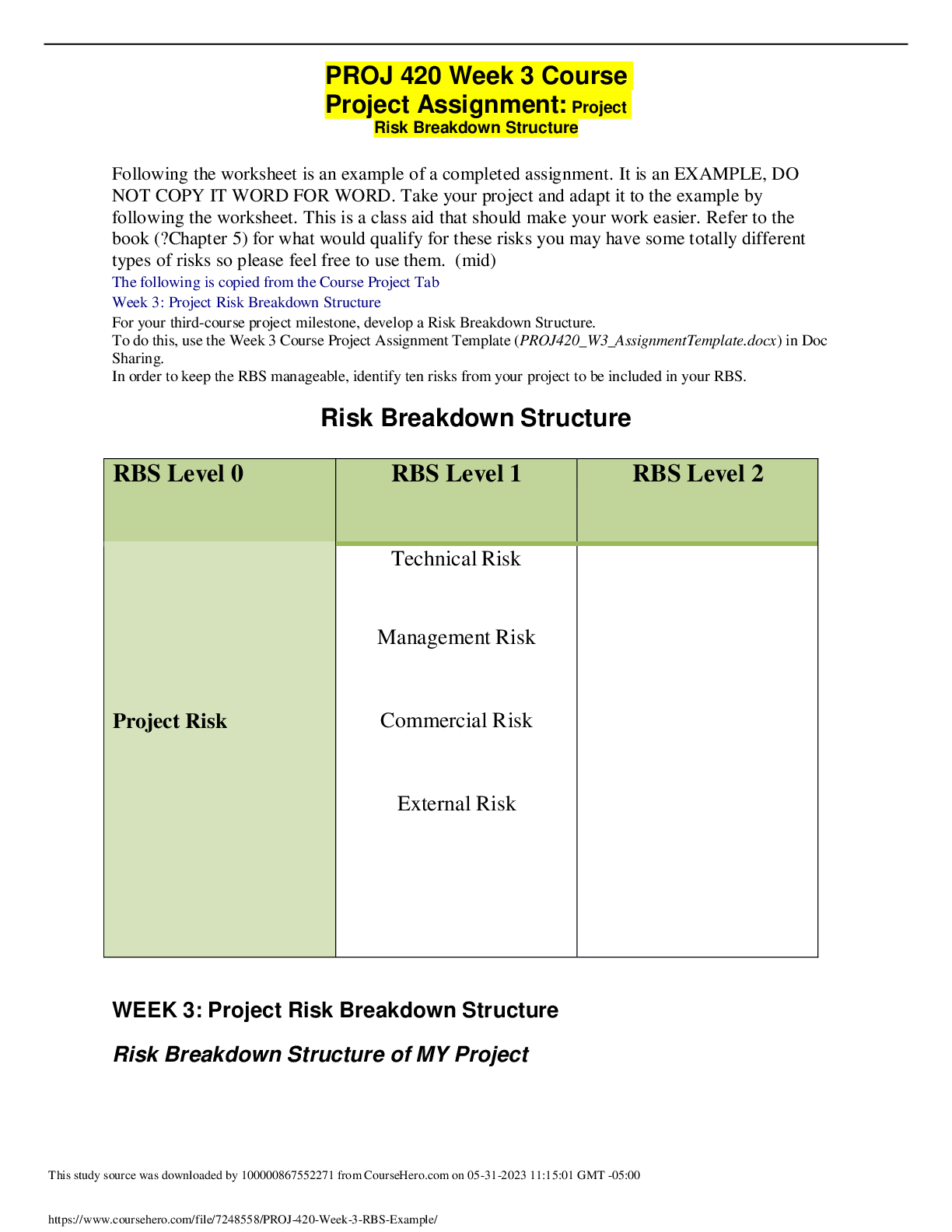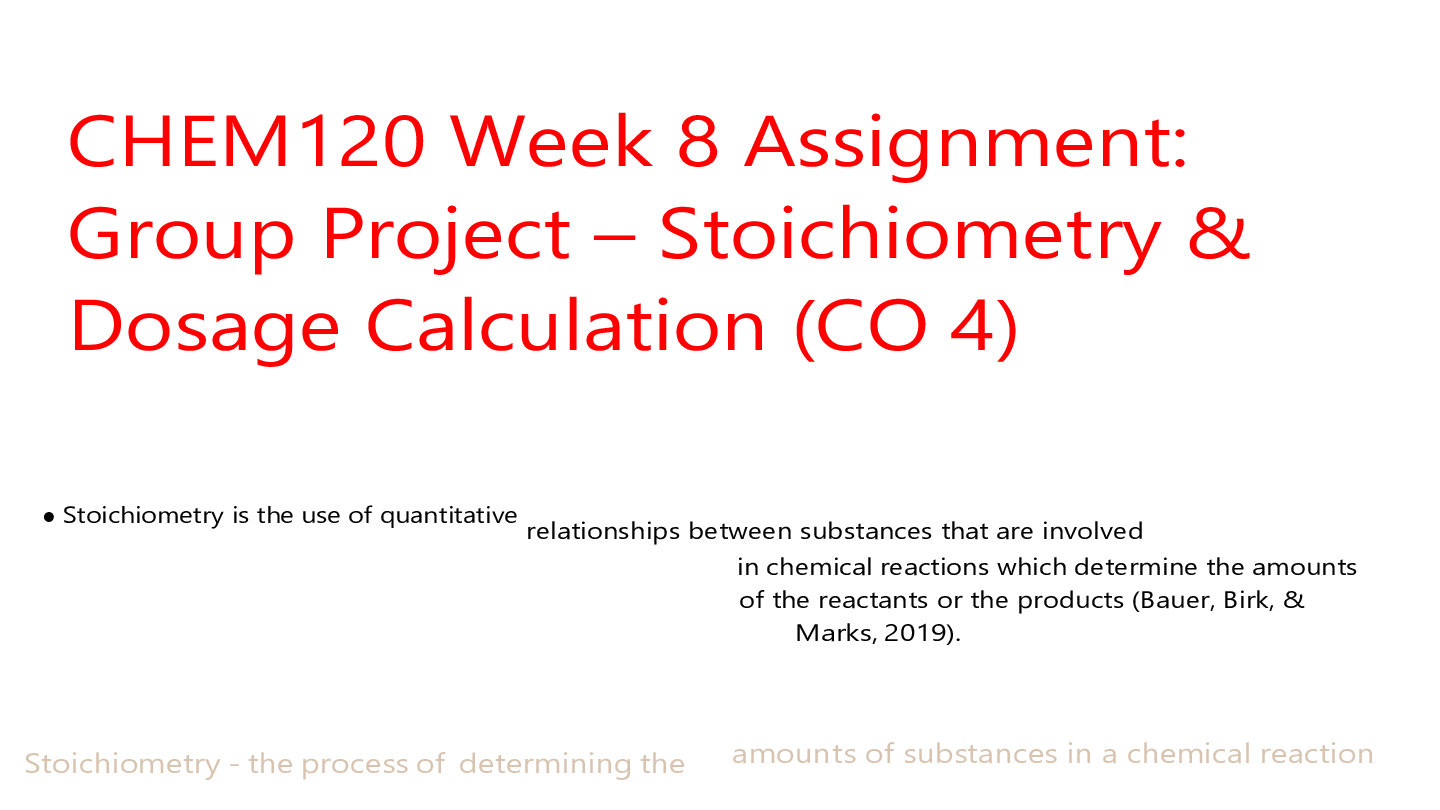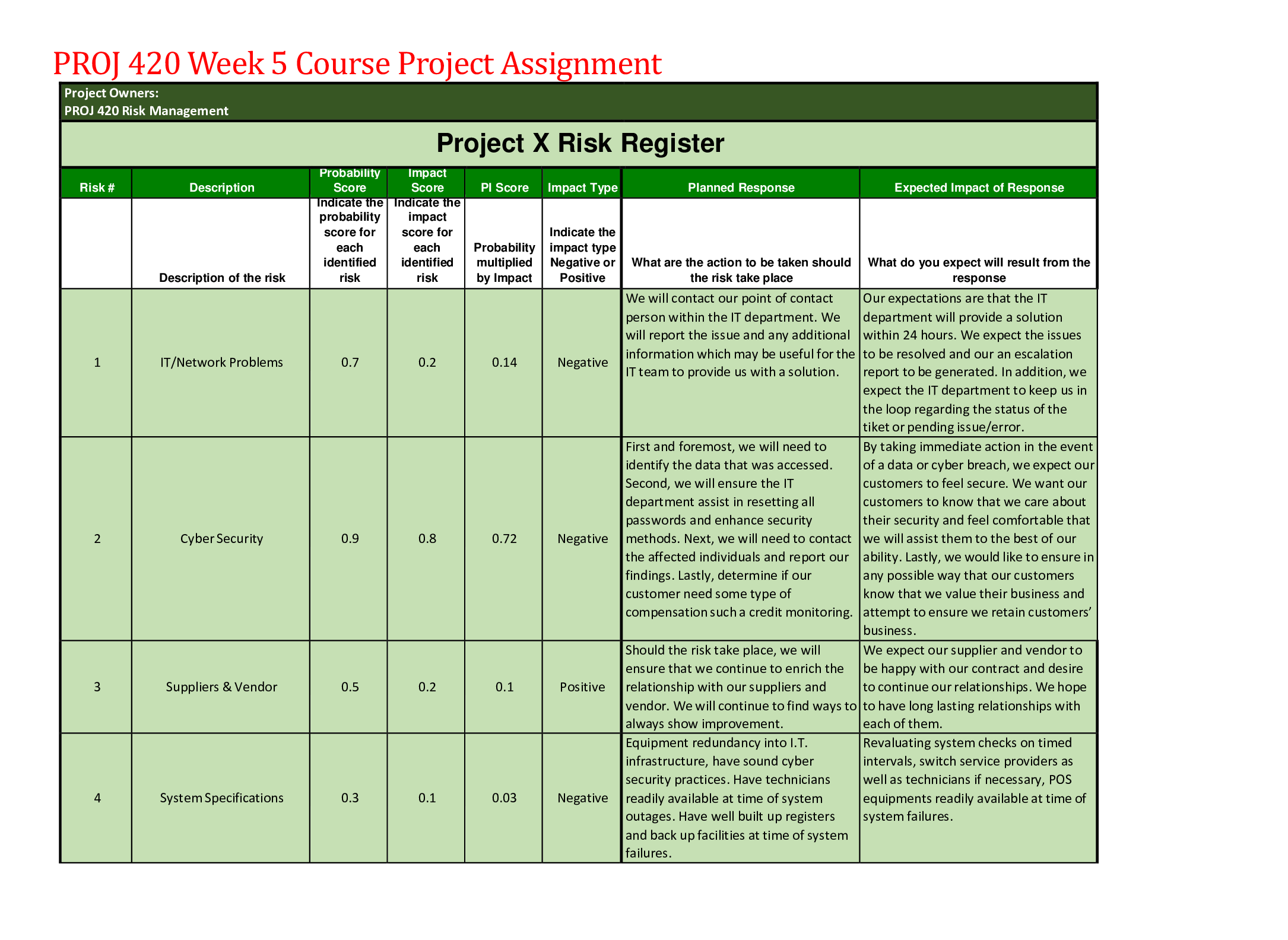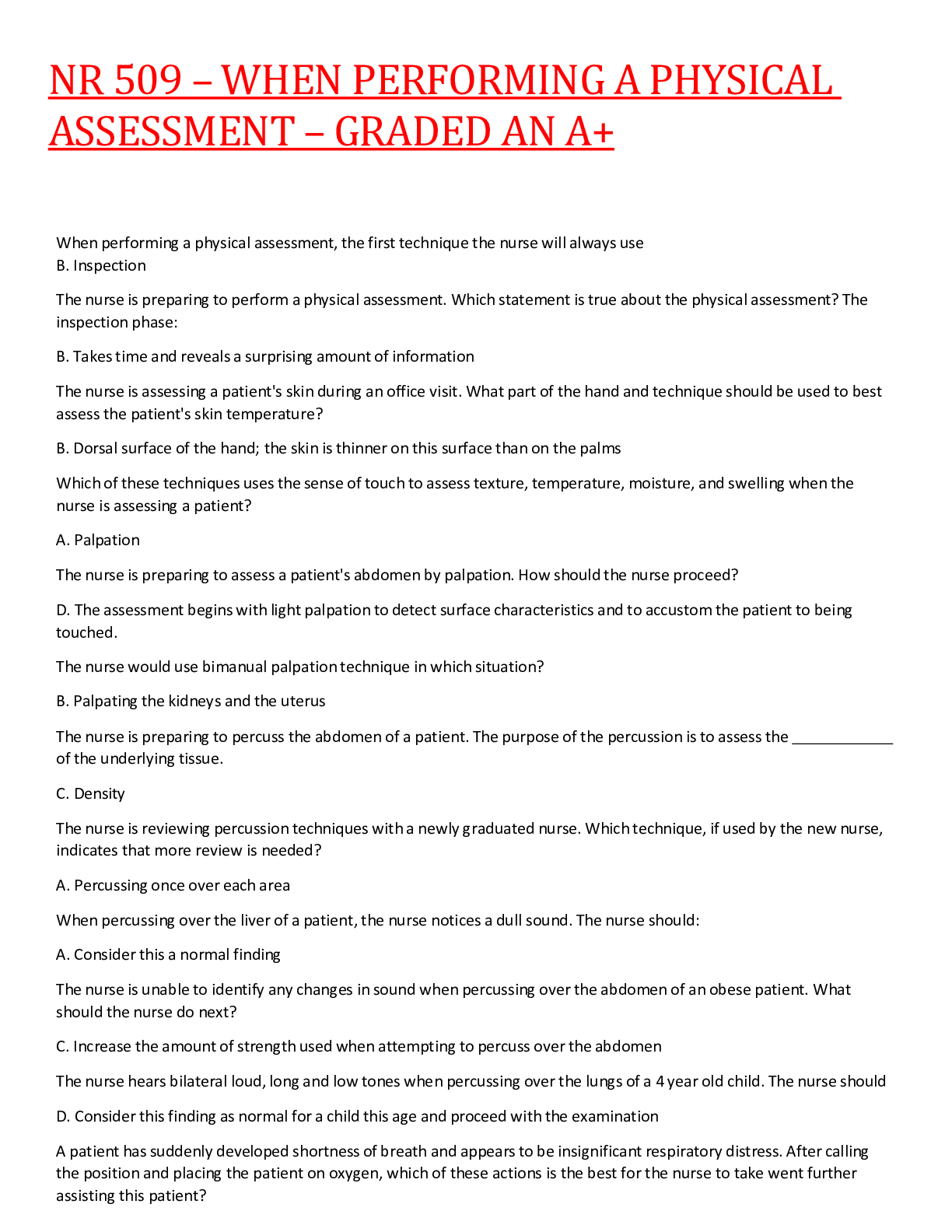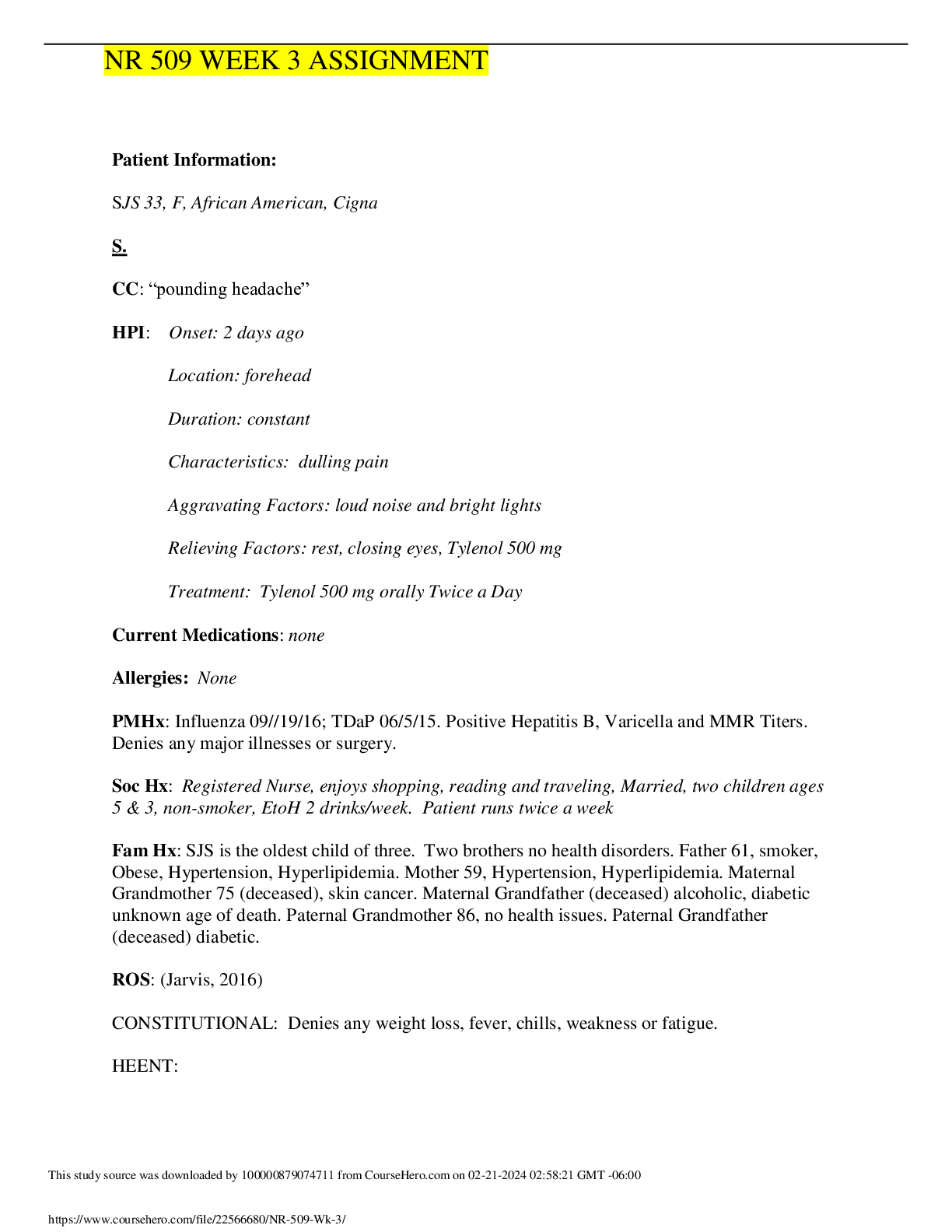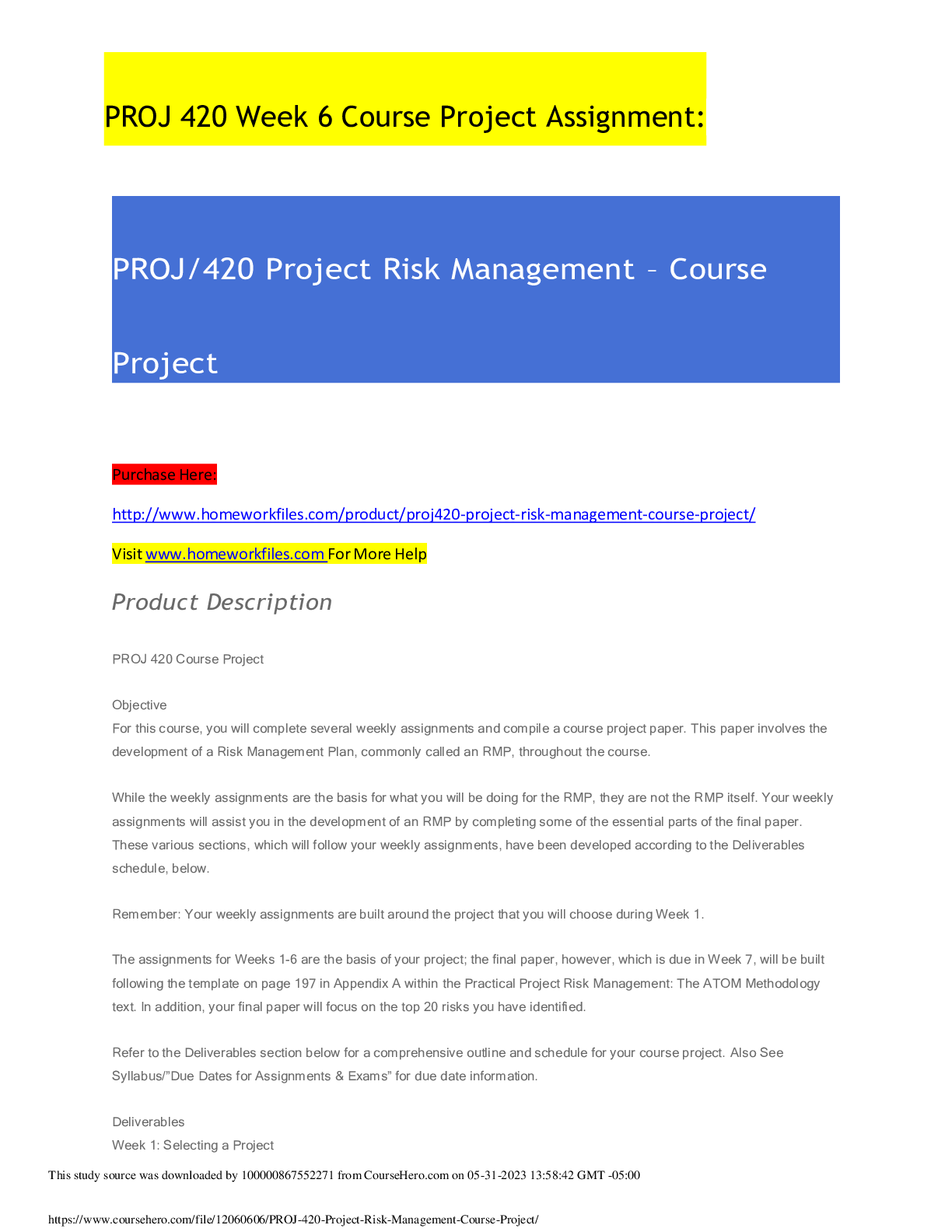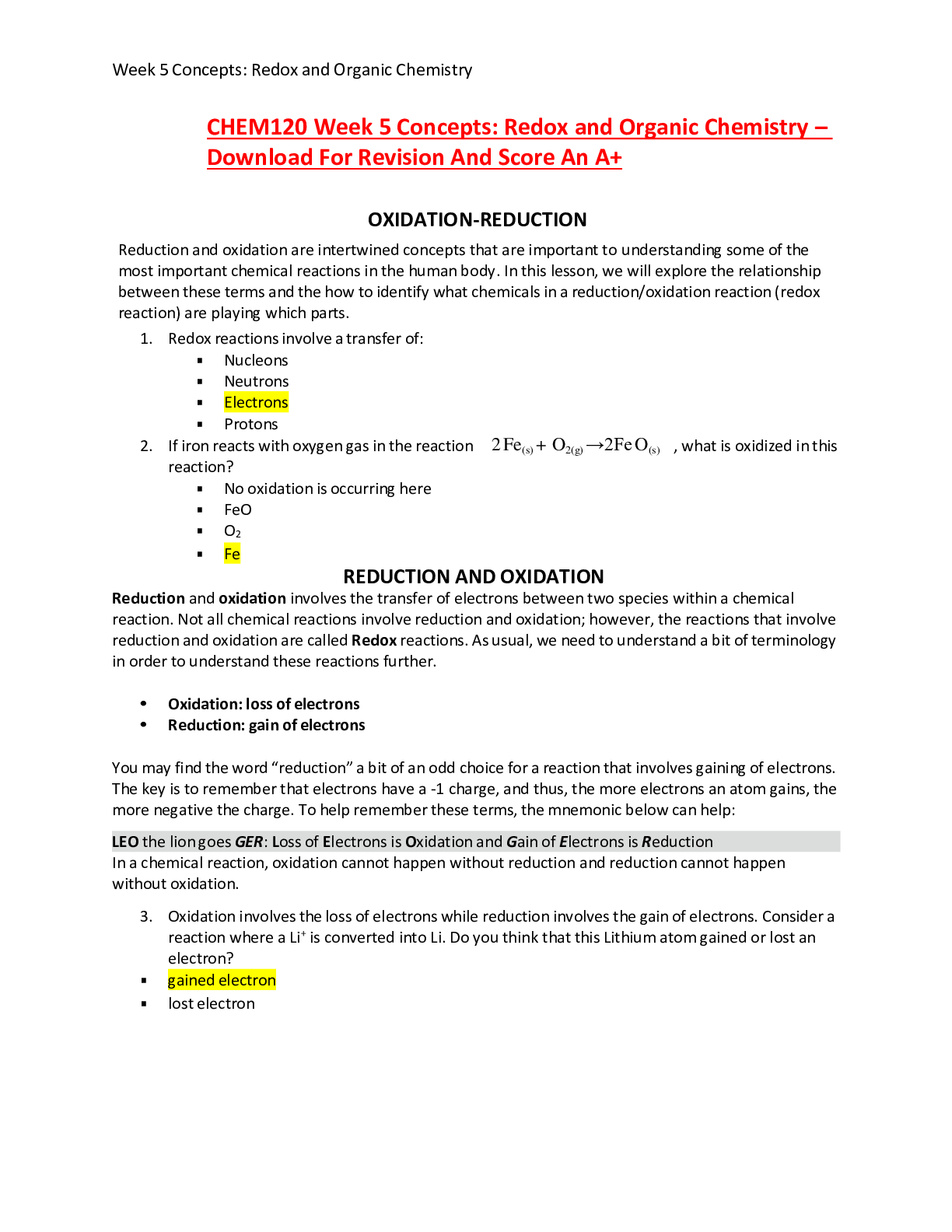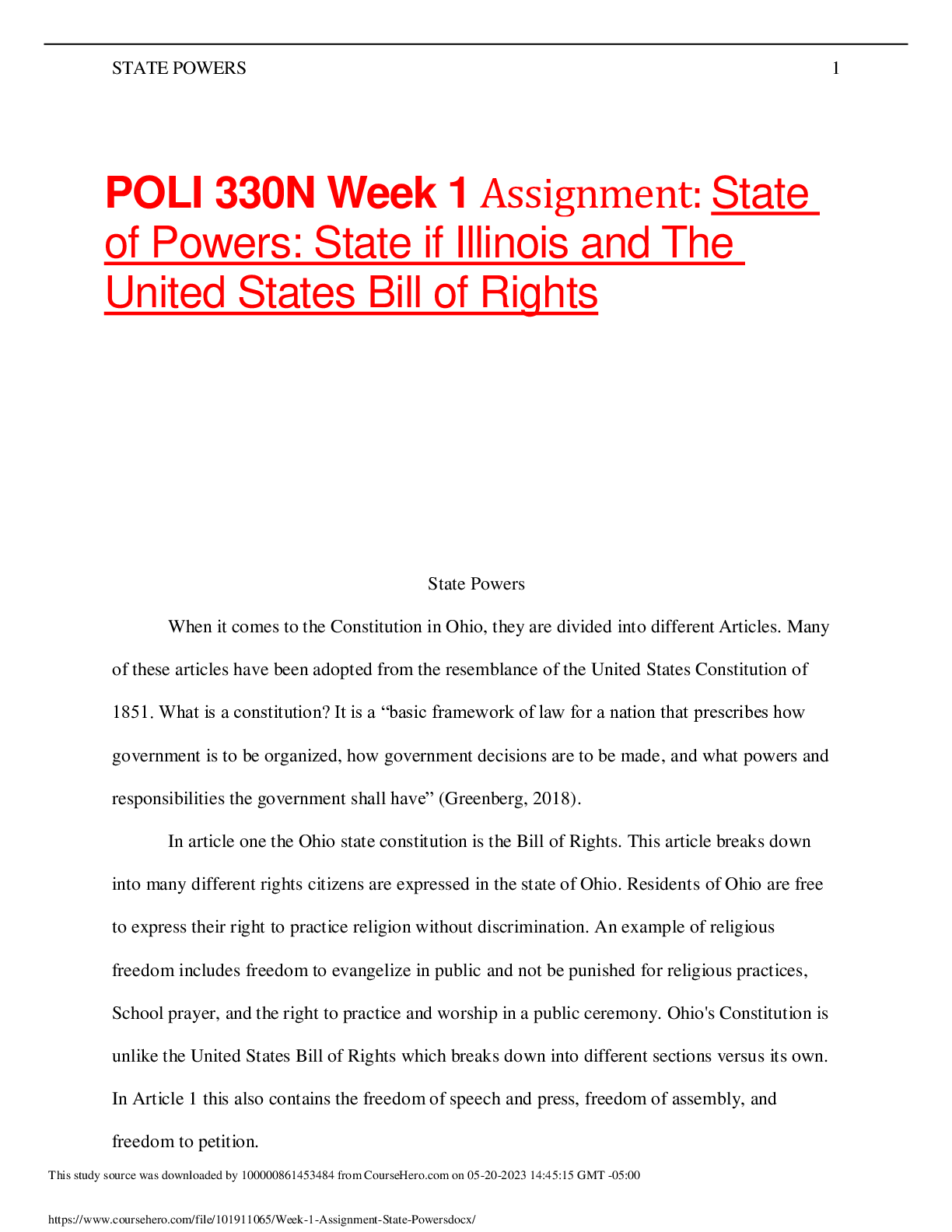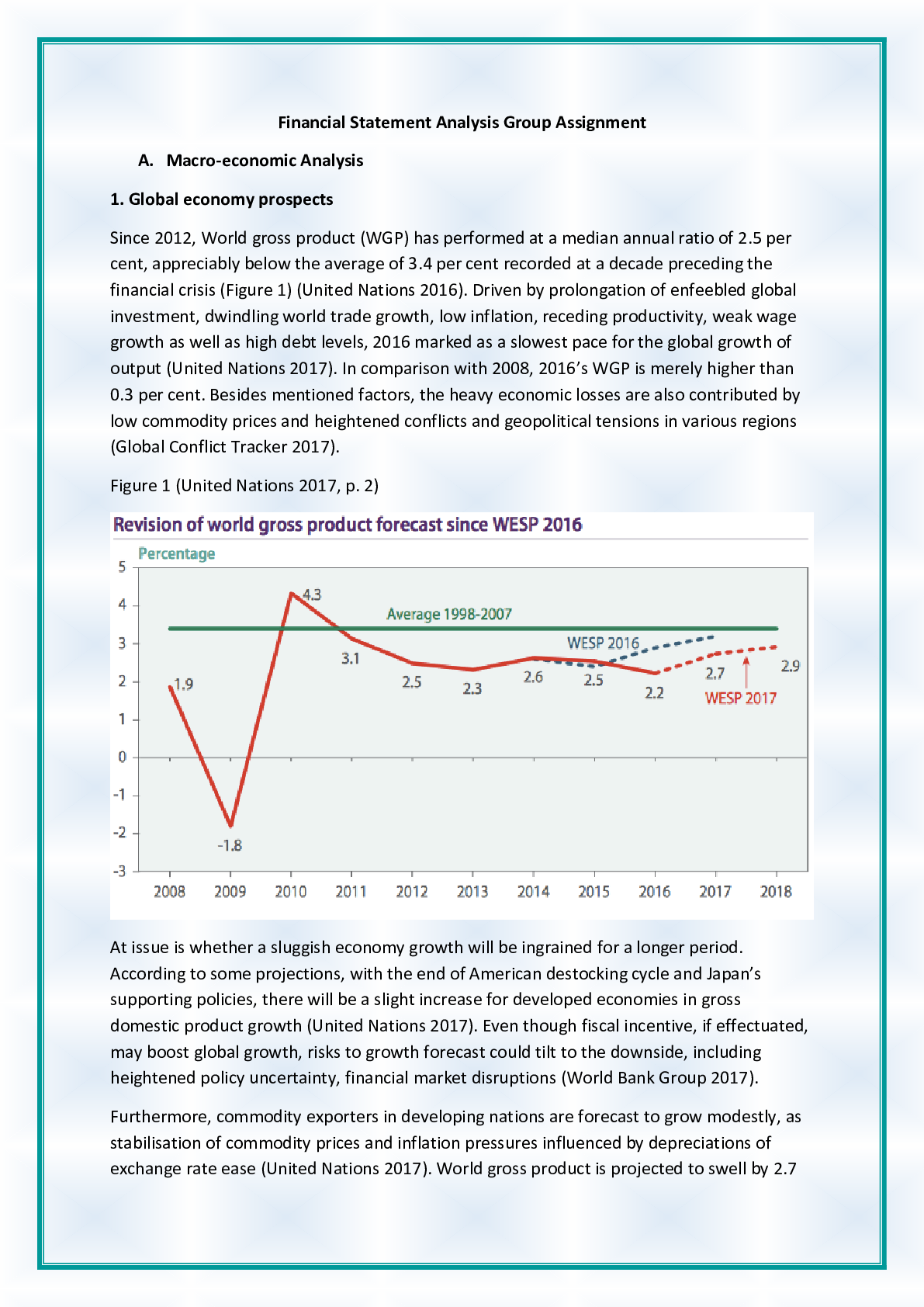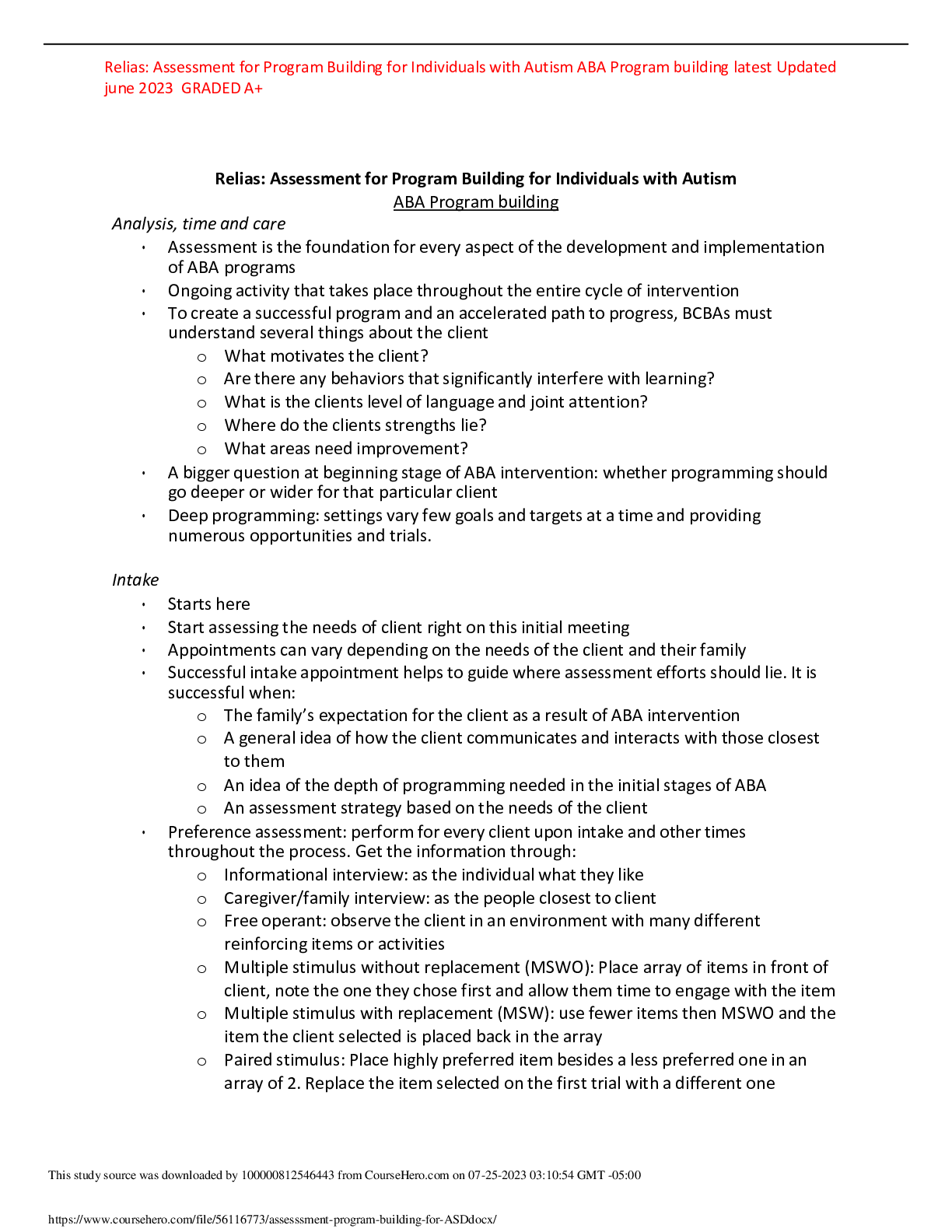*NURSING > ASSIGNMENT > BIOS 255 Week 1 Assignment: Case Study – Coagulation – Graded An A+ (All)
BIOS 255 Week 1 Assignment: Case Study – Coagulation – Graded An A+
Document Content and Description Below
1. Discuss which clotting factors the PT and PTT test evaluate and whether each test measures the intrinsic or the extrinsic pathways. The Prothrombin Time (PT) Test is used to identify or diagnose b... lood coagulation disorders or bleeding problems. Furthermore, there are a variety of reasons why this test is necessary. For example, when a patient is scheduled for major surgery, it informs the physician if the blood is clotting properly or if the patient is on warfarin (a blood thinner drug), among other things. The Prothrombin Time Test is carrying out in a lab/ hospital by a lab technician. The blood is obtaining from the venipuncture or fingertips and collected in a tube with sodium citrate to avoid blood cells from the plasma. The plasma is then mixed with tissue factors to test the clotting time. Thus, this will activate the extrinsic pathway of coagulation which will convert Prothrombin to Thrombin. In addition, calcium is added to the mixture to counteract the sodium citrate to allow coagulation to start. Hence, the time of coagulation, adding the calcium to the time the plasma clot is known as Prothrombin Time. What can be the Result? The Prothrombin (PT) Test looks for the presence of the following factors: I (Fibrinogen), II (Prothrombin), III (Prothrombin), IV (Prothrombin), V (Prothrombin), VI (Prothrombin (Prothrombin). V, VII, and X are the last three letters of the alphabet. The Prothrombin time will last around 9-12 seconds if the above factor is present, indicating that the patient has the normal level of the above clotting factors. A prolonged Prothrombin Time Test will reveal a lack of factors I, II, V, X, or VII. Liver disease, also known as vitamin K insufficiency. Also, if a patient is using warfarin, the testing may be prolonged, although it might be shortened if the patient can take the medications after the test. Thromboplastin Time (PTT) Test The Thromboplastin Time (PTT) Test analyzes concerns such as blood clotting, patients on heparin medication, recurrent miscarriage, and pre-surgery assessment. During the procedure, a phlebotomist or medical professional draws a blood sample from the patient's vein. The blood sample is obtained and transported to the laboratory. After centrifugation, the lab Technician will add calcium and other activated compounds to the plasma. As a result, the intrinsic coagulation pathway will be activated. Finally, the lab worker begins to time how long it takes for the blood to coagulate. What can be the result? The Thromboplastin Time (PTT) Test will assess the following factors: XII, XI, IX, VIII, X, V, II (Prothrombin); includes I (Fibrinogen) and high molecular weight kininogen (HK). As a result, a typical Thromboplastin Time (PTT) test will take around 35 seconds. If, on the other hand, the Thromboplastin time (PTT) test is extended, indicating that clotting is taking too long, this might be due to a variety of causes such as liver illness, vitamin K insufficiency, and other coagulation factors such as factors XII and XI.Thromboplastin Time (PTT) Test will evaluate for the following factors XII, XI, IX, VIII, X, V, II (Prothrombin); including I (Fibrinogen) as well as Prekallikrein (PK) and high molecular weight kininogen (HK). Thereby a standard Thromboplastin Time (PTT) test will take about 35 seconds. On the other hand, if the Thromboplastin time (PTT) test is prolonged, which means clotting is taking long to occur, this may be due to various factors like; Liver disease, Vitamin K deficiency, Intrinsic Pathway: The intrinsic route addresses an internal scenario in which platelets are engaged and release factor X11, which is followed by factor X1 to 1X. This route takes longer than the extrinsic pathway, but it is more significant since Factor 1X and V111 combine with calcium to activate Factor X. The intrinsic is clinically quantified as the partial thromboplastin time, and the entire process is known as cascade (PTT). Extrinsic Pathway: The extrinsic route refers to an external trauma that causes perivascular tissue or blood vessels to be damaged, such as a tiny puncture or splinter. This path is faster than the intrinsic path. Factor X is activated when thromboplastin (factor 111) from injured tissue is coupled with factor VII and calcium. As a result, the intrinsic and extrinsic routes merge. Furthermore, the prothrombin time is clinically used to assess the extrinsic route (PTT) 2. Describe the common coagulation pathway. This common coagulation route starts with factor X, which is triggered by extrinsic and intrinsic pathway processes. The intrinsic factor is VIII, factor IX, a phospholipid, and the extrinsic factors are VII, factor III (tissue factor), and Ca2+. After that, it converts Prothrombin into Factor II (Prothrombin). Factor X also needs factor V as a cofactor in order to convert Prothrombin to Thrombin. In addition, thrombin activates fibrinogen and converts it to fibrin. In the end, the fibrin, factor XIII, calcium, and the fibrin polymer combine to create a mesh. The platelet plug is stabilized with the aid of this mesh. 3. Based on Jessie's test, which factor deficiency do you believe he has and why? In Jessie's situation, we may state he has hemophilia, which could be caused by a lack of the following factors: 1X, V111, and X1. Usually, factor V111 is to blame for abnormal bleeding, which may be Jessie's case. 4. Jessie's clotting factor disease is seen more often in males. Please explain why. Because of its sex-linked recessive mechanism, hemophilia is a genetic illness. Furthermore, because she has two X chromosomes, this can only be passed through the mother. Males, on the other hand, have XY chromosomes, having received the X chromosome from their mothers and the Y chromosome from their dads. Females, on the other hand, acquired the X chromosome from both parents, making it easier for a female to be a carrier. Her offspring would be more likely to inherit the affected X chromosome with the clotting factor gene mutation. 5. If both the PT and the PTT tests were abnormally long, which part of the coagulation pathway would be affected? If both the Prothrombin Time (PT) and the Thromboplastin Time (PTT) tests are extended or abnormal, the problem is most likely in the common route. However, a lack of the following elements I, II, V, or X. Furthermore, a normal prothrombin time with an atypical Thromboplastin Time (aPTT) indicates a malfunction in the intrinsic route and a lack of factor VIII, IX, X, or XIII. Reference: Saladin, K. (2020). Anatomy & Physiology: The Unity of Form and Function (9th ed.). McGraw- Hill Education. [Show More]
Last updated: 4 weeks ago
Preview 1 out of 6 pages

Reviews( 0 )
Document information
Connected school, study & course
About the document
Uploaded On
Mar 29, 2024
Number of pages
6
Written in
Additional information
This document has been written for:
Uploaded
Mar 29, 2024
Downloads
0
Views
26

